#RIch Graziano
Text
“The other thing that takes a lot of time is the girls! There are always a lot of girls at every Grand Prix, but a lot of really young girl fans come to see me in Italy, 12 and 13-year-olds. I prefer older girls who are real fans of me as a racer – not teeny-boppers.” (Italian GP 1998)
“I have to say I don’t like leaving home to go racing at this time of year - there are too many beautiful girls around where I live, and they don’t wear so many clothes during the summer.” (British GP 1998)
Even back in his 125 and 250 days his infectious enthusiasm was breaking the sport to whole new audiences, amongst them the Valenteenyboppers, gangs of Italian schoolgirls drawn to racetracks by their heartthrob's pretty blue eyes. Valentino doesn't appreciate that kind of attention because he's a bit of a biking purist. “They're not fans of Rossi the motorcycle racer, but just because I've got blue eyes, I don't like,” he says with faint exasperation after years spent fleeing these seething ranks of moist, pubescent Latin lovelies. “It's good to have one or two nice girls chasing you, but not one thousand.” That's what he says, but you wonder if he really means it once you've been inside his motorhome, watching him and constant companion Uccio Salucci giggling madly as they field lewd text messages from female admirers.
Mat Oxley: It was Imola ‘97 that I realised he’d become a superstar – his fans covered half the hillside on the pit straight, so he was already more popular than Doohan and Biaggi. You’d go to his motorhome and there’d be 20 teenage girls hanging around outside, even though he had a girlfriend at the time.
Uccio: We really enjoyed having so many girls around! Maybe some top riders or superstars worry “Is this girl coming to see me because I’m famous or does she really like me?”, but Valentino didn’t think like that, he always said “I don’t care why she’s coming, I’m just happy that she is coming!”
Of course, with the late nights came the girls, and Valentino was getting through them at a rate. One of the few big-name riders to count himself ‘single’, he had finally copped onto the fact that he’s young, rich and the ladies love him, so, why on earth would he want to go steady just yet? As Italian MotoGP mover and shaker Carlo Pernat says: “I've never seen so many girls around a rider, maybe Barry Sheene or Marco Lucchinelli (500 world champ in 1981) but never so many. Valentino doesn't like to stay with a girl more than two or three months. He still lives like a kid now, with the same friends, the same way of life. After the racing is finished it's impossible to find him, no one knows where he goes, maybe he's in London, maybe he's in a disco with some friends he's known since he was a boy. He never changes, he doesn't want to be famous, he doesn't want a movie star girlfriend, he doesn't want to be in the papers with famous people.”
Valentino excuses himself by insisting that long-term girlfriends don't fit the GP lifestyle. “I brought a girlfriend to the Barcelona race but now is finished,” he said midway through 2003. When you make this life is very difficult to have a girl. If you bring her to a GP maybe she's bored, so I stay alone at races, is better. Then when you stay one week at a racetrack, you come back home and you have some power to use, you need to have fun, go out with friends, go to the disco, but your girlfriend has just stayed one week doing all this kind of stuff, so when I come home, she say ‘can we see a movie?'. So is difficult.”
Q: Did the life of a boyfriend change him?
Graziano: I don't think so, he keeps going dancing, but with his girlfriend.
Who would the MotoGP rider Valentino Rossi invite at dinner from the sports world? The Italian answered this question in an interview with Blick. “That's where I would call Roger Federer. We already had this pleasure in Portugal in 2006, but it was a long time ago. I do not know Cristiano Ronaldo and Lionel Messi on a personal basis, even if I would be interested at those two. Outside the world of sports, I would prefer a beautiful woman! When I was younger, I was loving the actress Angelina Jolie so much. But now she is old, like me (laughter). So I'd pick Scarlett Johansson. Having a nice woman next to me would be better than Roger!”, he said laughing.
“The first ride with the M1 was like going on a date with a new girlfriend: it's more exciting than having ice cream with a new girlfriend than having sex with one you've been dating for years!”
34 notes
·
View notes
Text
Me: *Randomly watch some genshin impact videos even though I don't play it because i have no patience for the game to get uploaded on my phone*
Me: *look at the fatui Harbinger* Why in the name of the holy Frogs they names are like this *point at Pantalone and Dottore* really who the frog name they Children, Pantalone and Dottore?! (Trousers and Doctor) Omg- 🤣🤣🤣
The Fatui Harbinger be like:
Pierro

〈pieró〉 (or Pierrot) sm, fr. [der. of the name Pierre «Peter»; owner «Pierino»]. – Character from Italian comedy in France, who originally represented the type of the foolish servant, who then moved on to French pantomime, where he gradually took on the character of a pathetic and unlucky lover.
Il dottore

(Unfortunately I can't post more than 10 photos so take this gif of Mr Bean 🙃, you guys can always look for it)
Balanzone, also known as Doctor Balanzone (Dutåur Balanzån in Bolognese), is a mask of Bolognese origin. He belongs to the ranks of the "old men" of commedia dell'arte, sometimes called Doctor Graziano or simply the Doctor.
Native of Bologna, he is the classic "serious", pedantic and presumptuous character. He is a doctor of law: he is in fact the caricature of the learned and pompous Bolognese lawyer. Its very name proves it, in fact Balanzone derives from the Bolognese balanzån, meaning balance, scales, meaning the symbol of the Law. A man with big red cheeks, he has a big belly and usually gesticulates a lot. He wears a small mask that covers only his eyebrows and nose, resting on two large moustaches. His costume represents the dress of the professors of the University of Bologna: black toga, white collar and cuffs, large Bolognese hat, black jacket and cloak. Fussy, quibbling, he finds every little excuse to start one of his endless meaningless speeches. Always ready to boast of his titles, he says he knows every field of human science: right and law first of all, but also history, astrology, philosophy; he talks about these topics in a boring and long-winded way, mixing them into an inextricable tangle. He enjoys a lot of respect among the other masks who often turn to him for legal advice: he does not deny his help but always takes the opportunity to do the thing he likes most: speaking and giving opinions of no value.
Columbina (Colombina)

Colombina is a Venetian mask from the commedia dell'arte, often the object of attention from her master Pantalone and the cause of Harlequin's jealousy.
The only female mask to stand out among so many male characters is Colombina, a lively and clever servant girl. She's lively, pretty, a liar and is from Venice. She is very fond of her equally young and pretty lady, Rosaura, and in order to make her happy she is willing to commit scam after scam.
Arlecchino

Arlecchino (in Bergamo dialect Arlechì) is a Bergamo mask from the commedia dell'arte.
Identified by his colored lozenge costume, his role is usually that of a carefree and cheerful, but also cunning servant, who acts to thwart the plans of his master Pantalone, in cahoots with his friend Brighella, and to pursue his interest loving, Colombina, with wit and resourcefulness. These characteristics make him assimilate to the typical role of the trickster.
(I'm pretty sure that i made a doll of him when i was in elementary school)
Pulcinella
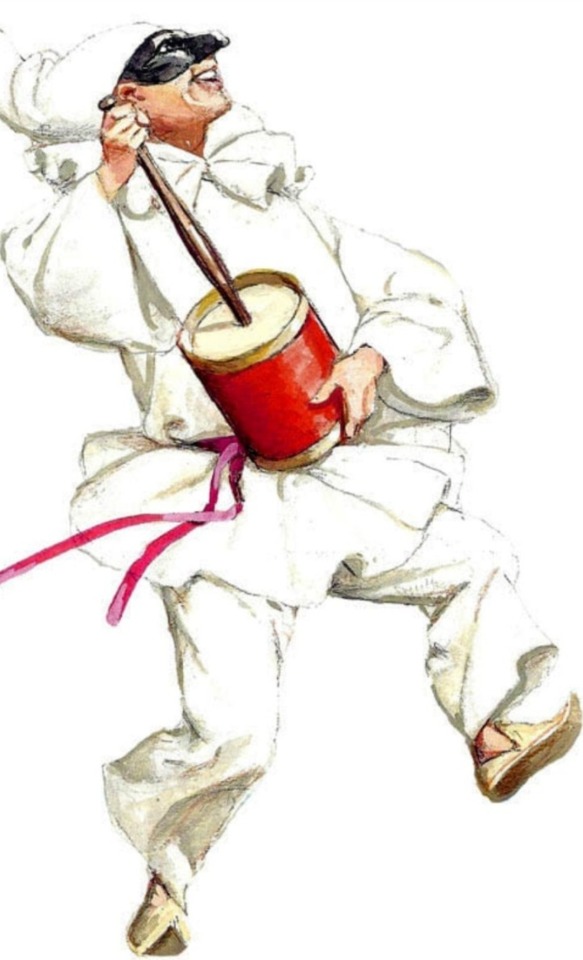
Pulcinella (derived from Puccio d'Aniello, in Neapolitan: Pulecenella) is a Neapolitan mask of the commedia dell'arte.
Pulcinella embodies the Neapolitan plebs, the simplest man, the one who occupies the last place on the social ladder, the man who, despite being aware of his problems, always manages to come out of them with a smile. He is called to represent the soul of the people and their primitive instincts, he almost always appears in contradiction, so much so that he does not have fixed traits: he is rich or poor, he adapts to do all jobs in addition to being a faithful servant, here he is a baker, innkeeper, farmer, thief and seller of miraculous concoctions, he is either arrogant or cowardly, and sometimes presents both traits at the same time by making fun of the powerful. The quality that best distinguishes Pulcinella is his cunning, and it is precisely with his proverbial cunning that he manages to find the ability to solve the most disparate problems that arise before him, but always in favor of the weakest to the detriment of the powerful. Another famous characteristic of his is that of never being able to keep quiet and this is where the expression “pulcinella's secret” comes from, i.e. something that everyone knows. Pulcinella represents a character who has acquired within himself all the symbols and meanings of the popular and peasant world and has brought to all the scenes of Italian theaters, and beyond, a repertoire rich in movements, gestures, acrobatics, typical dances and rituals of the Neapolitan gestural code. In fact, they accompany him on the theater and carnival scenes: the broom, the horn, the cowbells, elements which for the Neapolitans have a propitiatory value and an antidote against the evil eye and jinx.
Scaramouche

Scaramuccia is a mask from the commedia dell'arte, derived from the Captain: boastful and boastful, he dressed in black according to the uniform of the Spaniards stationed in Naples. In truth, however, the mask was born in Naples with the name Scaramuzza, taking on the form Scaramuccia (Tuscan) in the eighteenth century.
(Oh and there is also a film that its called Scaramouche but it doesn't has nothing to do with the mask i think-)
Sandrone

Sandrone (Sandróun in Modenese) is the traditional mask of the city of Modena.
Sandrone represents the peasant of the past, rough, but smart and shrewd. He is the spokesperson of the most humble and mistreated people, and always looking for stratagems to make ends meet.
La signora
No mask found, but translated into English means The lady
Pantalone

Pantalone (in Venetian Pantalón) is a Venetian mask and a character from the commedia dell'arte.
Pantalone initially appears as a vicious old man who undermines the young lovers, the courtesans, more often the servants of the comedy.
represents the typical old, stingy and lustful merchant: his very name is the one typically imposed on the males of the wealthy families of the Serenissima.
Tartaglia
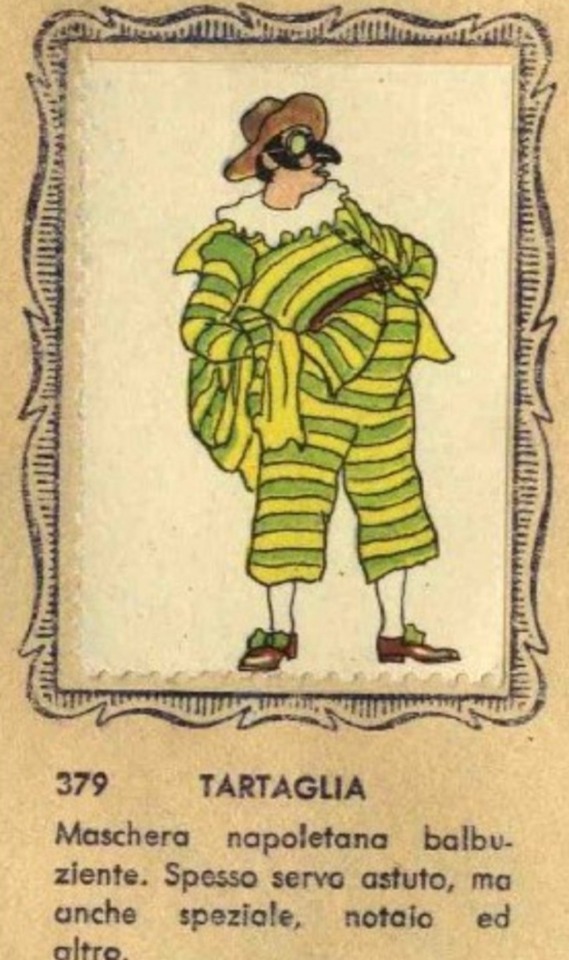
Tartaglia is a mask of the commedia dell'arte, born in Genoa at the beginning of the 1600s. It is similar to that of the doctor, from which it derives.
His main characteristic (hence the name) is stuttering.
Il capitano

The captain is one of the oldest masks of commedia dell'arte.
Reborn in other forms in the Italian theater of the 1500s, he sometimes personified the noble and imaginative soldier or the vainglorious braggart who boasted of titles he did not possess and of deeds never accomplished: in both cases he actually poorly concealed the terror of having to face a battle or a duel, contrary to what he continually stated in words.
Like they are almost all (-La signora) Italian masks for comedies?! I can't take them seriously anymore 🤣🤣🤣
I don't think that they the personalities match those of the masks but idk anything about them soo~ i could be wrong ^^
If you guys are interested in the Lore of the masks you can just look for them or ask me questions about them if i reamber something
Oh and I used the Google translator because I feel lazy right now
#genshin impact#fatui harbingers#I just ruined everything for everyone-#😈#🤣🤣🤣#omg- but really#i feel like they did it on purpose and i am just repeating things making me look stupid#which I already was#🙃
9 notes
·
View notes
Photo







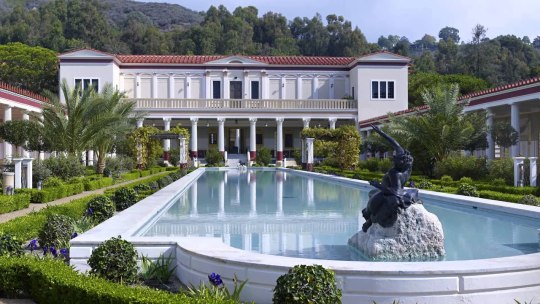
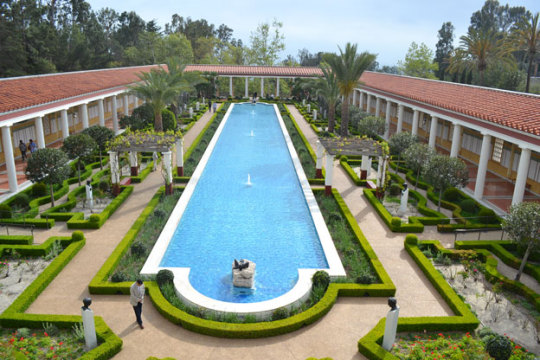


Vast Subterranean Aqueduct in Naples Once 'Served Elite Roman Villas'
Once played in by local children, a vast tunnel that goes through a hill in Naples, Italy, is actually a Roman aqueduct.
Forty years ago, when children in Naples were playing in caves and tunnels under the hill of Posillipo in Italy, they didn't know their playground was actually a Roman aqueduct. When they shared their memories with archaeological authorities recently, it kicked off an exploration of one of the longest, most mysterious examples of ancient water infrastructure in the Roman world.
Rome's famous aqueducts supplied water for baths, drinking, public fountains and more. Built during a period of about half a millennium (roughly 300 B.C. to A.D. 200), aqueducts around the former Roman Empire are highly recognizable today thanks to their multitiered arched structure. But this marvel of ancient architecture represents only a small fraction of the actual water system; the vast majority of the infrastructure is still underground.
Outside of Rome, subterranean aqueducts and their paths are much less understood. This knowledge gap included the newly investigated Aqua Augusta (opens in new tab), also called the Serino aqueduct, which was built between 30 B.C. and 20 B.C. to connect luxury villas and suburban outposts in the Bay of Naples. Circling Naples and running down to the ancient vacation destination of Pompeii, the Aqua Augusta is known to have covered at least 87 miles (140 kilometers), bringing water to people all along the coast as well as inland.
But the complex Aqua Augusta has barely been explored by researchers, making it the least-documented aqueduct in the Roman world. New discoveries earlier this month by the Cocceius Association (opens in new tab), a nonprofit group that engages in speleo-archaeological work, are bringing this fascinating aqueduct to light.
Thanks to reports from locals who used to explore the tunnels as kids, association members found a branch of the aqueduct that carried drinking water to the hill of Posillipo and to the crescent-shaped island of Nisida (opens in new tab). So far, around 2,100 feet (650 meters) of the excellently preserved aqueduct has been found, making it the longest known segment of the Aqua Augusta.
Graziano Ferrari (opens in new tab), president of the Cocceius Association, said in an email that "the Augusta channel runs quite near to the surface, so the inner air is good, and strong breezes often run in the passages." Exploring the aqueduct requires considerable caving experience, though. Speleologists' most difficult challenge in exploring the tunnel was to circumvent the tangle of thorns at one entrance.
"Luckily, the caving suits are quite thornproof," he said. "After succeeding in entering the channel, we met normal caving challenges — some sections where you have to crawl on all fours or squeeze through."
In a new report (opens in new tab), Ferrari and Cocceius Association Vice President Raffaella Lamagna (opens in new tab) list several scientific studies that can be done now that this stretch of aqueduct has been found. Specifically, they will be able to calculate the ancient water flow with high precision, to learn more about the eruptive sequences that formed the hill of Posillipo, and to study the mineral deposits on the walls of the aqueduct.
Rabun Taylor (opens in new tab), a professor of classics at the University of Texas at Austin who was not involved in the report, said in an email that the newly discovered aqueduct section is interesting because it is "actually a byway that served elite Roman villas, not a city. Multiple demands on this single water source stretched it very thin, requiring careful maintenance and strict rationing."
Taylor, an expert on Roman aqueducts, also said the new find "may be able to tell us a lot about the local climate over hundreds of years when the water was flowing." This insight is possible thanks to a thick deposit of lime, a calcium-rich mineral that "accumulates annually like tree rings and can be analyzed isotopically as a proxy for temperature and rainfall," he explained.
Ferrari, Lamagna and other members of the Cocceius Association plan to analyze the construction of the aqueduct as well, to determine the methods used and the presence of water control structures. "We believe that there are ample prospects for defining a research and exploration plan for this important discovery, which adds a significant element to the knowledge of the ancient population" living in the Bay of Naples, they wrote in the report.
By Kristina Killgrove.
#Vast Subterranean Aqueduct in Naples Once 'Served Elite Roman Villas'#posillipo italy#roman aqueduct#aqua augusta#serino aqueduct#bay of naples#pompeii#archeology#archeolgst#ancient artifacts#history#history news#ancient history#ancient culture#ancient civilizations#ancient rome#roman empire#roman history
40 notes
·
View notes
Text
Hi Everyone,
Today I want to blog about gender, as a by product personality. It’s not that I think gender is one personality, even if you believe in only two, there’s treats and characteristics that form into a system. The Big 5 is an evidence based framework to reimagine gender, for a moment.
Because our lives are intricately woven by the threads of personality traits, and these traits are universal, often transcending boundaries of gender and sexual orientation is a by product of an overall personality system. People don’t come along express this transcendence, with out first, expressing something like imaginative, innovative or open to experience. Thus if personality is both genetic and environmental, so to is the collective personality that takes form here in earth as gender and orientation. So, gender and orientation are specifically now, we're going to be talking about it, but not directly by names, but as Big Five traits like: openness, conscientiousness, extraversion, agreeableness, and neuroticism (John, Naumann, & Soto, 2008). It’s here, that we can say gender almost exclusively certainly but some of us, have more of this, the adaptive and maladaptive, than others. While individuals may vary, collectives have a general tendency, something we can measure as “feminine”, and masculine”, or both, we can even say maladaptive and adaptive. Depending on the time location and era that this personality comes to be, too. If there is beginning, certainly there is a middle, and end to duration and frequency of that too.
The Big Five: A Brief Overview
Openness encapsulates our willingness to embrace new experiences and ideas, fostering creativity and innovation (McCrae & Sutin, 2009). Conscientiousness, our sense of responsibility and dependability, often promotes success in professional environments and healthier lifestyles (Bogg & Roberts, 2004). However,
Extraversion, our level of outgoingness and social interaction, can bolster our social lives and help us form new relationships (Ashton, Lee, & Paunonen, 2002). Agreeableness, characterized by kindness, empathy, and cooperation, often strengthens social bonds and aids in conflict resolution (Graziano & Tobin, 2009).
Neuroticism, a tendency towards negative emotions, can pose challenges, contributing to mental health issues, but it can also be associated with high levels of creativity and a deep sense of empathy (Kaufman, 2013).
Diving Deeper: Traits Across Sexual Orientations
Research suggests that people of different sexual orientations may show variations in these Big Five personality traits. For example, studies have found that gay men and women might score higher on neuroticism and openness compared to their heterosexual counterparts (Lippa, 2005). Similarly, bisexual individuals may exhibit higher openness and extraversion compared to heterosexual individuals (Juster et al., 2013).
A Look at Androgyny
When we consider the concept of androgyny, it refers to the display of both traditional masculine and feminine characteristics. However, it's not just about appearance or behavior; it's also about personality traits. Androgynous individuals often show a higher degree of flexibility in their personality traits, potentially blending the strengths of both genders (Bem, 1974).
Concluding Thoughts
In sum, the Big Five personality traits are a universal aspect of human nature, but they can manifest in subtly different ways across different sexual orientations. Understanding these nuances not only helps us appreciate the rich diversity of human personalities but also challenges traditional notions of gender and sexual orientation.
References
Bem, S. L. (1974). The measurement of psychological androgyny. Journal of Consulting and Clinical Psychology, 42(2), 155–162.
John, O. P., Naumann, L. P., & Soto, C. J. (2008). Paradigm shift to the integrative big five trait taxonomy. Handbook of personality: Theory and research, 3(2), 114-158.
Juster, R. P., Smith, N. G., Ouellet, É., Sindi, S., & Lupien, S. J. (2013). Sexual orientation and disclosure in relation to psychiatric symptoms, diurnal cortisol, and allostatic load. Psychosomatic Medicine, 75(2), 103–116.
Lippa, R. A. (2005). Sexual orientation and personality. Annual Review of Sex Research, 16(1), 119-153.
McCrae, R. R., & Sutin, A. R. (2009). Openness to Experience. In M. R. Leary & R. H. Hoyle (Eds.), Handbook of individual differences in social behavior (pp. 257–273). The Guiliford Press.
Kaufman, S. B. (2013). Opening up openness to experience: A four-factor model and relations to creative achievement in the arts and sciences. The Journal of Creative Behavior, 47(4), 233–255.
Bogg, T., & Roberts, B. W. (2004). Conscientiousness and health-related behaviors: A meta-analysis of the leading behavioral contributors to mortality. Psychological Bulletin, 130(6), 887–919.
Graziano, W. G., & Tobin, R. M. (2009). Agreeableness. In M. R. Leary & R. H. Hoyle (Eds.), Handbook of individual differences in social behavior (pp. 46–61). The Guiliford Press.
Ashton, M. C., Lee, K., & Paunonen, S. V. (2002). What is the central feature of extraversion? Social attention versus reward sensitivity. Journal of Personality and Social Psychology, 83(1), 245–252.
1 note
·
View note
Text
A Tribute to Sugar Ray Robinson
(adsbygoogle = window.adsbygoogle || []).push({});
By Sina Latif
Follow @Frontproofmedia!function(d,s,id){var js,fjs=d.getElementsByTagName(s)[0],p=/^http:/.test(d.location)?'http':'https';if(!d.getElementById(id))(document, 'script', 'twitter-wjs');
Published: May 03, 2023
When speaking about Walker Smith Jr, otherwise known to box fans as Sugar Ray Robinson, Muhammad Ali referred to him as “the king, the master, my idol.”
Joe Louis said Robinson was “the greatest fighter to ever step into the ring.”
“Beauty, power, greatness, perfection — Sugar Ray Robinson was the best,” said Sugar Ray Leonard.
Take a moment to comprehend the caliber of the men giving Robinson such high praise. Some of the finest to ever grace the sport bowed down to Robinson as the greatest of them all.
Robinson fought great opposition at activity levels that are unheard of in modern boxing, and it is surreal when one considers the number of quality opponents he was consistently fighting and defeating while fighting so regularly. Robinson’s accomplishments will never be equaled.
In 1946, the year Robinson finally won the welterweight title, he fought 16 times. In 1947, he fought 10 times. In 1948, he had somewhat of a quiet year, fighting five times, before fighting 13 times in 1949, and he fought on an astonishing 20 occasions in 1950.
Ray fought 18 world champions and defeated 10 Hall of Famers. The great fighters that he defeated include Jake LaMotta, Henry Armstrong, Sammy Angott, Fritzie Zivic, Kid Gavilan, Carmen Basilio, Gene Fullmer, Randy Turpin, Rocky Graziano, and Bobo Olson.
The original Sugar Ray was a revolutionary fighter during the ’40s and ’50s. He had his own style and made it work. He could do certain things in the ring unconventionally and have success. Robinson was simply too advanced for his time.
Robinson possessed magnificent all-around skills, terrific timing, quick feet, power in both hands, great jab, hand speed, ring IQ, strength, granite chin, heart, brilliant combination punching, stamina, and courage. Fluidity and power while throwing triple hooks with either hand. Great athleticism paired with great all-around boxing ability. The general consensus is clear; Sugar Ray Robinson is the most complete fighter to have ever set foot in a boxing ring.
Ray was vicious but graceful. He defied all limitations of boxing. He was that rare breed of fighter who was brutal but elegant. A.J. Liebling described Robinson as “the epitome of ring grace,” but he was also a chilling puncher with vicious power in both fists.
Ray once said: “Rhythm is everything in boxing. Every move you make starts with your heart, and that’s in rhythm or you’re in trouble. Your rhythm should set the pace of the fight. If it does, then you penetrate your opponent’s rhythm. You make him fight your fight, and that’s what boxing is all about.”
After a brilliant amateur career in which he went 85 fights undefeated with 69 KOs and 40 KOs in the first round, winning two New York Golden Gloves championships along the way, he turned professional in 1940 at the age of 19.
Over a career spanning a quarter of a century, from 1940 to 1965, Robinson recorded 174 victories, 19 losses, and six draws, with 109 KOs.
Robinson was welterweight world champion from 1946 to 1951, then became an unprecedented five-time middleweight world champion between 1951 and 1958.
The welterweight division is known for its rich history and amazing talent. “Barbados” Joe Walcott, Armstrong, Kid Gavilan, Leonard, just to name a few of the legends to grace the 147 lbs division. The most accomplished of them all. Sugar Ray Robinson. There have been few fighters throughout history who were so utterly talented and special in their prime that they were considered unbeatable in any era of their optimal weight class. Roberto Duran’s reign of terror as world lightweight champion was devastating for all opponents. A prime Duran at 135 lbs was the ultimate fighting specimen. A peak Roy Jones Jr was dominant and simply unbeatable as a super-middleweight. Sugar Ray Robinson was untouchable as a welterweight. Then, in an equally historically revered division as a middleweight, he was competitive well beyond his prime against the roughest competition and cemented his place as one of the greatest middleweights ever.
Within 12 months of turning professional and after a mere 20 professional fights in 1941, Robinson had defeated Angott, an experienced 80-fight veteran who would become the best lightweight of his era. From the very start, Robinson was fighting frequently and fighting great opposition. He proceeded to beat Angott twice more in his career.
Four fights and two months after the first Angott fight, in September 1941, Robinson was only 20 when he beat undefeated veteran Marty Servo before again defeating Servo via split decision a year later.
In February 1943, Robinson completed three 10-rounders in four weeks, and two of them were against fellow Hall of Famer LaMotta. Later that same year, Robinson defeated another all-time great in Armstrong, the legendary prizefighter and Robinson’s idol, who holds the distinction of holding world titles in three divisions at a time when there were only eight divisions altogether.
Ray was unbeaten in 40 fights before losing in his 41st bout against LaMotta in February 1943, losing a ten-round decision to a man who out-weighed him by 16 lbs. It was now 1–1 between the pair as Robinson had previously defeated “The Raging Bull,” and they proceeded to fight four more times to create one of boxing’s most epic rivalries. In the end, Robinson won five of their six clashes, but Robinson stated that LaMotta was his most brutal opponent.
Robinson and LaMotta served fight fans with a legendary rivalry and cemented an everlasting legacy for one another.
LaMotta was famously quoted as saying: “The three toughest fighters I’ve ever been up against were Sugar Ray Robinson, Sugar Ray Robinson, and Sugar Ray Robinson. I fought Sugar so many times, I’m surprised I’m not diabetic!”
After losing to LaMotta, Robinson went on a 91-fight unbeaten streak for the next eight years.
After finally defeating boxing politics along with the best welterweights, Robinson got his first welterweight title shot on December 20, 1946, against Tommy Bell, who he outpointed to win the vacant title. At this point, Robinson had a phenomenal record of 74–1–1.
In September 1948, Robinson beat the great Kid Gavilan via unanimous decision in a 10-rounder. Less than a year later, they had a rematch. Robinson proved too strong and won another unanimous decision over 15 rounds.
His loss to Lamotta was his only loss in Robinson’s first 132 fights, in which he recorded 84 knockouts.
During his long career, arguably his most impressive feat is that while moving through 46 lbs in weight, no man could knock out the original Sugar Ray. Only the unbearable heat in Yankee Stadium managed to do that during a fight in which the referee had to be replaced at the end of the 10th round due to the intense heat. Ray had dominated the bewildered 175 lbs light-heavyweight champion Joey Maxim for 13 rounds before collapsing at the end of the 13th due to disorientation as a result of the heat, and the fight was over. This was the only time Robinson had lost a fight within the distance.
Ray fought in a magnificent era with many great fighters and fought them while they were at their best.
A fitting manner in which to conclude would be to quote the former president of boxing at Madison Square Garden, Harry Markson:
"With all due respect to all the good fighters who were before my time, I can’t conceive of a better fighter than Ray Robinson, and here’s why: If you take all the requisites necessary for a great boxer, you find that Ray Robinson not only possesses them all, but does everything to perfection. Everybody agrees on that. So, to be better than Ray Robinson you have to improve on perfection. I ask you — is that possible?"
(Featured Photo: The Ring Archive)
2 notes
·
View notes
Photo

Tuscany, Italy / Graziano Ottini
Experience the essence of Tuscany through the lens of Graziano Ottini's photography. Discover the enchanting landscapes, charming villages, and rich culture that make Tuscany a must-visit destination. Let your imagination transport you to this picturesque corner of Italy.
0 notes
Text
United States Steel Corporation (X) Q1 2023 Earnings Call Transcript
$X Q1 2023 Earnings Call Transcript #earnings #markets #investing
United States Steel Corporation (NYSE:X) Q1 2023 Earnings Call dated Apr. 28, 2023.
Corporate Participants:
Kevin Lewis — Vice President, Finance
Dave Burritt — President and CEO
Jessica Graziano — Senior Vice-President and CFO
Rich Fruehauf — Senior Vice-President and Chief Strategy and Sustainability Officer
Analysts:
Emily Chieng — Goldman Sachs — Analyst
Tristan Gresser — Exane BNP Paribas —…

View On WordPress
0 notes
Text
St. Zita, Patroness of Homemakers

Feast day: April 27th
Patronage: Domestic servants, homemakers, lost keys, people ridiculed for their piety, single laywomen, waiters, waitresses, Italian City of Lucca
St. Zita was born into a poor but holy Christian family. Her older sister became a Cistercian nun and her uncle Graziano was a hermit whom the local people regarded as a saint. Zita herself always tried to do God's will obediently whenever it was pointed out to her by her mother. At the age of twelve Zita became a housekeeper in the house of a rich weaver in Lucca, Italy, eight miles from her home at Monte Sagrati. As things turned out, she stayed with that family for the last forty-eight years of her life. She found time every day to attend Mass and to recite many prayers, as well as to carry out her household duties so perfectly that the other servants were jealous of her. Indeed, her work was part of her religion! She use to say: "a servant is not holy if she is not busy; lazy people of our position is fake holiness." At first, her employers were upset by her generous gifts of food to the poor, but in time, they were completely won over by her patience and goodness and she became a very close friend. St. Zita was given a free reign over her working schedule and busied herself with visits to the sick and those in prison. Word spread rapidly in Lucca of her good deeds and the heavenly visions that appeared to her. She was sought out by the important people, and at her death in 1278 the people acclaimed her as a saint. She is the patroness of domestic workers. Her feast day is April 27.
27 notes
·
View notes
Text
Staying on top of what's in locally is a far more manageable feat than understanding scenes across the pond or past the southern border. However, the Internet has made accessing the menswear scene in Mexico City or the shirtmakers on Savile Row or the boot-making industry in Léon easier than ever. And, to be frank, you should be shopping from these independent brands over fast fashion stores anyway.
This isn't an exhaustive list detailing every brand there is to know from each of Mexico's 32 states. Not even close. Instead, this is a starting place, a sampler to whet your appetite, a thread to pull. Six interesting Mexican brands spanning the outdoor industry, the psychedelics space, streetwear, and beyond.
Mucha Carne

From: Mexico City, Mexico
Founded: 2020
Focus: GORP/Outdoors
About: The brand caters to an outdoors-savvy clientele. There is a foldable trucker hat cut from water-resistant nylon; a micro water-resistant ripstop pant; a not-so-subtle pair of bottoms with hidden pockets and embedded stretch called Psylocibin; a heavyweight belt with a magnetic buckle, and a Kangaroo pocket-equipped shirt.
Sabina Green Combo Foldable Hat:

Casa Caballeria

From: Mexico City, Mexico
Founded: 2014
Focus: Footwear
About: A retail store with its own in-house footwear and apparel lines, Casa Caballeria was founded by Eduardo Dubost. 5he shop acts as a barber and retailer.
The store is best known for its footwear, an eponymous collection of boots and shoes and rubber soles. But that's not all. One-off originals — tops, bottoms, accessories and beyond — they've made appear on the site, and in the shop, often.
Bota Teo:

Graziano and Gutiérrez

From: Oaxaca, Mexico
Founded: 2020
Focus: Workwear
About: Originally launched as a part of co-founders Sam Graziano and Alejandro Gutierrez's senior thesis, Graziano and Gutiérrez is a slow fashion brand dedicated to showcasing Mexican craftsmanship and classic workwear silhouettes. Focused on "providing a platform for Mexican artisan work, transparency and education, and environmental responsibility," the duo designs seasons with only a few items, each handmade in either Oaxaca or Chiapas by artisan communities the company's established long-term manufacturing partnerships with.
"The goal is to create pieces to preserve, honor, and share the incredibly rich heritage of Mexico while also providing a platform for the artisans’ work to shine," the brand's founders explain. "Working directly with these communities allows us to provide consistent fair-work and pay for them and teach our customers about Mexican traditions at large and, specifically, the communities that weave the fabrics used to make the clothing."
Verde Work-Pant:

Hermanos Koumori

From: Mexico City, Mexico
Founded: 2018
Focus: Streetwear
About: "If we just look at it from the outside, Hermanos Koumori is a contemporary streetwear brand based in Mexico City, but for us it is much more than that," co-founder Alex Leon tells us. "We [Leon and co-founder Alejandro Sandler] see it as a studio that has the versatility to move through different areas like art, objects, literature and graphic design to name a few. We are passionate about stories and narratives, that is why for each one of our collections we create a fictional universe that helps us with the inspiration behind them."
Hermanos Koumori's collections have focused on a fictional airline imagined by a Mexican novelist, ancient running clubs, baseball and beyond. The clothing's streetwear-leaning — suit separates made from ripstop fabric, natural cotton vests — but sensible still. Best of all, it's designed to withstand everyday wear.
El Viajero Dark Olive Pants:

The Pack

From: Mexico City, Mexico
Founded: 2015
Focus: Luxury
About: Founded by Mexico City-born designer Patricio Campillo, luxury label The Pack reinterprets traditional Mexican menswear for a modern audience. Referencing how Charros (aka horsemen) used to dress, Campillo creates uniforms for Charros today: embellished jackets, flared pants, and embroidered footwear.
Preserving and challenging tradition, he plucks pieces from the past and tweaks them, freeing them from constraints imposed by gender identity. Campillo isn't only socially conscious, though. He's grown The Pack while maintaining commitments to both sustainable sourcing and artisan craftsmanship, adhering to fair trade standards for both.
Unmarked

From: Léon, Mexico
Founded: 2011
Focus: Footwear
About: Hugo Fonce, designer for Unmarked, wants to spotlight craftsmanship found in Léon, Mexico, the country's footwear capital. For Unmarked, lemon-wood pegs, invisible channels, leather-lining and intricate embroidery are details inherent to the brand.Emphasizing quality and aesthetics, every release is timeless in two ways: most are resoleable, thus prolonging their lifespan, and most are classic men's styles with little chance of ever falling from favor. It's hard to overstate how incredible Unmarked's boots look and feel. Plus, their prices are incredibly fair given what they could charge.
#🇲🇽#mexico#clothes#clothing#style#shirts#pants#support#mexico city#oaxaca mexico#oaxaca#leon mexico#leon#artisan
1 note
·
View note
Text
It’s Ridiculous: The Story Behind Fast 9’s Mid-Engine, Hellcat-Powered ’68 Dodge Charger
You can only ask this question in the context of a Fast and Furious film: How do you top a ’68 Dodge Charger with a jet engine in the trunk? Easy—a ’68 Charger with a Hellcat in the back seat. How does a Hellcat engine, even one tuned to Demon specification like this one, top a jet engine? Because it’s real.
That’s right, kids, the jet engine sticking out the back of the “Ice Charger” in 2017’s Fate of the Furious was just a prop. The car was powered by a Chevy LS3 V-8 pushed back under the dashboard to make room for an all-wheel-drive system. Cool stuff, but the mid-engine Charger is the real deal.
At least, two of them are.
“We actually built nine,” says Dennis McCarthy, picture car coordinator at Universal. His shop, Vehicle Effects, built the cars for the past seven Fast films and for the Hobbs & Shaw spinoff.
“Now, when I say we built nine, they’re not all identical,” he explains. “There’s two of them that were built with the mid-engine design and the transaxle. The rest, the name of the company leaves me at the moment, but there’s a company that makes a plastic Hellcat motor. So the rest of them have the [fake] plastic motor in place. And we actually used an LS3 with a manual-shifted Turbo 400 automatic and a Ford 9-inch rearend for our stunt cars that we just use and abuse. But yeah, a total of nine cars, two different platforms. I’d say four and a half months, they were all done and headed off to different countries.”
The hero cars, the ones actors drive in close-up shots, have real Hellcats and actually run. Mopar provided the standard 707-hp crate engines, and McCarthy had them brought to Demon spec with a pully and a 110-octane race-gas tune from Performance Tech, the shop that tunes all the Fast movie cars. The now 800-plus-hp motors were mated to six-speed manual Graziano transaxles lifted from Lamborghini Gallardos.
“I feel that the clutch pedal is a key ingredient to the cool factor,” McCarthy says. “In my opinion, it just has to be that way. An automatic just wouldn’t have the same impact.”
Rich Waitas at Magnaflow built a full custom exhaust with custom headers that route up and over the transaxle and dump out of hidden tips behind the rear bumper. With no engine up front and no room left for the original under-trunk gas tank, Vehicle Effects mounted an 8-gallon fuel cell under the hood. The classic chrome gas cap on the passenger front fender is functional on the mid-engine cars, making trips to the gas station more like filling up a Porsche than a Dodge.
Also under the hood is a high-angle rack-and-pinion power steering setup to enable big drifts. That and the transaxle necessitated a custom fully independent suspension at all four corners, and it gives the front-engine stunt cars a tell: the live rear-axle pumpkin hanging down. That is, if you can get low enough to see it.
“I’m always into the lowest stance possible [for the cars],” McCarthy says. “I might have gone a little too far on this one. It’s definitely the lowest Charger we’ve ever put together, which is great. It looks awesome. But sometimes you get that high-center issue going in and out of the driveway with such a long-wheelbase car. But for a movie car, that’s great; for a daily driver, you’d probably want to raise it up a couple of inches.”
All these pieces are fitted to a custom chassis built by Wisconsin-based SpeedKore Performance, which also created the carbon-fiber widebody to go over the top. The Charger Daytona roofline and rear glass were chosen both to clear the Hellcat engine and to show it off. The body and chassis were modified to stretch the wheelbase nearly 6 inches by moving the front axle forward, mostly because McCarthy doesn’t like the big front overhang featured on early Chargers. Deep-dish HRE wheels fill out the fat fenders and hide modern Brembo disc brakes.
“It’s without a doubt the fastest Charger we’ve built,” McCarthy says. “There have been a lot of Chargers that look like they have 1,000 horsepower; this one in reality is probably the highest horsepower Fast and Furious Charger ever built.”
Replacing the rear seat with a supercharged V-8 requires a lot of interior modification. A metal and plexiglass divider helps reduce some of the heat and noise coming into the cabin, which is sparse but functional. McCarthy took design inspiration from the Ford GT40, going so far as to incorporate brass rings in the seat covers. The bucket seats are adjustable, with tools, and don’t have headrests for a period feel. Between them is, of course, a NOS bottle for the inevitable scene where even more acceleration is necessary to save the day. A flat instrument panel with simple analog gauges and toggle switches, plus a steel three-spoke steering wheel, completes the old-school look.
“The tricky thing is always trying to come up with something new,” McCarthy acknowledges, “because there’s only so many ways you can build a Charger, and we’ve done most of them. And on top of that, not only have we built numerous Chargers in different styles, but we’ve used the Nelson Racing Engines Charger, that unpainted Charger, we’ve borrowed other Chargers from SpeedKore, so there’s a long list of Chargers that have been featured in the franchise over the years.
“Like I said, it’s always trying to come up with something new. When I was at SEMA, the SpeedKore guys were showing me what they were working on, which looked pretty badass. And then, I don’t know who owns this car, so I can’t give him credit for it, but there was a Mustang—I want to say it was maybe a ’71ish Mustang—that had a mid-engine setup in it, which was very impressive. I don’t want to take credit for other people’s ideas, but I get a lot of ideas at SEMA. One thing led to another, and I just decided that’s something we haven’t done yet. Let’s move the motor to a new location.”
The work is surprisingly clean considering McCarthy and a team of seven had only those four and a half months to build all nine cars from scratch. And really, it was Jonny Miller and Brian Gogerty who did most of the work on the mid-engine cars while the rest of the team built the stunt cars or moved back and forth between builds.
“As always, our biggest challenge is just trying to get it done in time,” McCarthy says. “Guys are working on the car for sometimes 14, 15 hours a day, and trying to keep sane for weeks and weeks and weeks on end. But they have a lot of practice. And obviously these were extremely labor-intensive cars to build. You talk to a guy, for instance at SEMA, who built a car, they’ll go, ‘Oh, we worked on it for three or four years.’ We’ll build 180 cars in five months. It’s a whole different style of building cars, but the nice thing is you don’t have to get each door gap exactly perfect. So there are some advantages. But they do have to perform and be reliable. And they were very reliable; they had no problems during filming. They fired right up every time.”
It’s an important consideration when a custom star car can make or break a shooting schedule. At one point, the two mid-engine cars were simultaneously in Glasgow, Scotland, and Tbilisi, Georgia, shooting different scenes. These are places you don’t just buy Dodge parts at the local shop.
Despite all the travel and shooting, the hero cars came back in near-perfect condition.
“I was adamant with the guys,” McCarthy says. “Don’t kill the mid-engine car. They both came back unscathed. No damage, nothing. It was great. And that’s not normal. Usually even the cars I don’t want to get damaged end up getting damaged one way or another.”
That’s good for a lot of reasons, not least of which because the cars have a lot of traveling left to do. They’ll split up again and ship around the world on a promotional tour for Fast 9, then at least one will likely end up on display at one of the Universal Studios theme parks. Before they go, though, McCarthy hopes to get them out to a track and dialed in properly.
“The only thing I regret is, we didn’t have a lot of track time,” he says. “Normally we’ll build these cars, and we’ll head out to Willow Springs for the day and run them through their paces. With this car, we were just in such a time crunch to get them shipped out. I think I made one pass up and down the street in front of my shop, and everything felt good. Into a shipping container it went, and that was it.
“Hopefully,” he continues, “when we get a little bit closer to movie release time [on June 25], we can take this car out and put it through its paces and see what it does. I have a bad feeling it’s going to have a little bit of an understeer push characteristic to it, because it’s just a ton of power, real sticky tires, and we never even scaled the car. I got to believe it’s 62, 63, or 64 percent rear weight bias on the car. But hopefully with a little track time, we’ll get that tamed and see what the thing can really do.”
The post It’s Ridiculous: The Story Behind Fast 9’s Mid-Engine, Hellcat-Powered ’68 Dodge Charger appeared first on MotorTrend.
https://www.motortrend.com/news/fast-9-mid-engine-charger/ visto antes em https://www.motortrend.com
1 note
·
View note
Text
Headlines
U.S. election officials warn of November chaos due to budget crunch
(Reuters) A Michigan town wants machines to speed up counting of absentee ballots. In Ohio, officials want to equip polling places so voters and poll workers feel safe from the coronavirus. Georgia officials, rattled by a chaotic election last month, want to send voters forms so they can request absentee ballots more easily. In all three cases, the money is not there to make it happen, say local officials responsible for running elections in the states. This year’s nominating contests have shown that voting in the pandemic age costs more: Officials have to buy masks, face shields and other equipment to virus-proof polling places. They also must spend more to mail and count ballots. Many officials say they don’t have the funding to do either job properly. Election experts say Americans are likely to vote in record numbers in November, when control of Congress will also be up for grabs along with state governorships and legislatures. A funding shortfall could lead to “widespread disenfranchisement,” said Myrna Perez, director of the elections program at New York University’s Brennan Center for Justice, a non-partisan public policy institute. “We run the risk of people really questioning the legitimacy of the election.”
Landmark Supreme Court Ruling Affirms Native American Rights in Oklahoma
(NYT) The Supreme Court on Thursday ruled that much of eastern Oklahoma falls within an Indian reservation, a decision that could reshape the criminal justice system by preventing state authorities from prosecuting offenses there that involve Native Americans. The 5-to-4 decision, potentially one of the most consequential legal victories for Native Americans in decades, could have far-reaching implications for the people who live across what the court affirmed was Indian Country. The lands include much of Tulsa, Oklahoma’s second-biggest city. The case was steeped in the United States government’s long history of brutal removals and broken treaties with Indigenous tribes, and grappled with whether lands of the Muscogee (Creek) Nation had remained a reservation after Oklahoma became a state. Muscogee leaders hailed the decision as a hard-fought victory that clarified the status of their lands. The tribe said it would work with state and federal law enforcement authorities to coordinate public safety within the reservation.
‘Maybe I Shouldn’t Have Come’: U.S. Visa Changes Leave Students in Limbo
(NYT) Oliver Philcox was nearing the end of his first year of graduate studies in astrophysics at Princeton University when the coronavirus outbreak began. Classes were halted in March, and then moved online. By May, he had decided to travel home to Britain. “In the long run, that was a terrible idea,” said Mr. Philcox, 24. “But I had assumed I would be able to go back in September.” Now, the return to an American institution has been thrown into question for Mr. Philcox and countless other international students after a directive by the Trump administration that students whose classes were moving entirely online for the fall would be stripped of their visas and required to leave the United States. Many universities see the move as a political one—an attempt to pressure them to reopen rather than hosting all classes online during the pandemic. For some international students, the directive poses frustrating questions of logistics and uncertainty. But for others—notably those whose home countries are embroiled in conflict or have communications technologies that are insufficient for online learning—the decision has the potential to disrupt their lives and drastically alter their futures. The Trump administration’s plan to require in-person classes for international students would affect around one million students. China sends the highest number of students—with about 370,000 enrolled in American universities in 2018-2019—followed by India with just over 200,000 students enrolled that year.
Bolivian president has COVID-19 as virus hits region’s elite
(AP) Bolivia’s interim president and Venezuela’s No. 2 leader announced Thursday that they have been infected with the new coronavirus, just days after Brazil’s leader tested positive as the pandemic hits hard at some of Latin America’s political elite. Three Cabinet ministers in the administration of Bolivian leader Jeanine Áñez have also tested positive for the virus. The infections in Venezuela, Brazil and Bolivia, which is seeing a spike in cases, come after Honduran President Juan Orlando Hernández tested positive in June and was briefly hospitalized.
Stuck at Home Because of Covid, the French Discover France
(WSJ) The French are venturing into unknown territory: France. Every summer French vacationers snub their homeland in favor of far-flung destinations, allowing France, the world’s top tourism destination, to become a playground for foreign tourists. That means millions of French have never climbed the Eiffel Tower; or soaked up views from the summit of Mont Blanc; or sauntered along Nice’s palm tree-studded Promenade des Anglais. The French have never seen themselves as “Leven als god in Frankrijk,” as the Dutch like to say, or “Living like a god in France.” It’s an embarrassment of riches that has long stood in contrast with the perennial malaise that many French feel toward France. “Being French is to live in a paradise inhabited by people who think they’re in hell,” Sylvain Tesson, the French adventurer, once wrote. With border reopenings in flux around the world due to the coronavirus pandemic, however, the French suddenly have France to themselves, and they’ve decided it’s time to see what all the fuss is about. A survey of 2,000 French vacationers released last month by Protourisme, a French consultancy, found that 86% of respondents are planning to vacation in France this summer.
Flood-weary Venice puts “Moses” inflatable barriers to test
(Washington Post) Venice has conducted a trial run of an ambitious anti-flood system of 78 inflatable barriers in hopes of protecting the lagoon city from devastating high tides. Premier Giuseppe Conte on Friday at a ceremony in Venice pressed a button that activated compressors to pump air into the bright yellow barriers, which then started rising from the sea to act as a kind of a dike-on-demand. The project, riddled by corruption, was supposed to be working in 2011. Now the latest date is 2021, but Conte expressed hope it could be ready by this autumn. In November 2019, Venice suffered its worst flooding in more than 50 years. The project’s name, Moses, recalls the Biblical figure who, the Old Testament recounts, parted the waters of the Red Sea. But it also is the Italian acronym for Experimental Electromechanical Modules. The movable flood gates are attached by hinges to cement blocks on the seabed along three openings from the sea into the lagoon. After high-tide danger ceases, sea water is pumped into the gates to make them heavy so they can be lowered.
At 78, a Sardinian ex-kidnapper is on the run
(Economist) Some said Graziano Mesina had absconded to the neighbouring French island of Corsica; others that he had fled to Tunisia. But what became increasingly clear on July 3rd was that the man known as the last balènte, or Sardinian bandit, was yet again on the run—at the age of 78. His younger sister, Antonia Mesina, said he had called by her house the previous day, just before the supreme court in Rome turned down her brother’s appeal against a 30-year sentence for a drug-trafficking offence. “I’ve not seen or heard from him since,” she said. Police carried out house-to-house searches in his home town of Orgosolo, but soon learnt that no one else could—or, perhaps, would—help them. The town’s mayor said it was a coincidence that a surveillance camera near Mr Mesina’s house had twice been shot up before he vanished. But if there was complicity in the reaction to his disappearance, it may have had less to do with the code of silence that once shielded Sardinia’s brigands than resentment towards Italy’s sluggish judicial system. Mr Mesina’s case had dragged on through the courts for seven years. Grazianeddu, as he is half-affectionately known, has been the subject of books, films and songs. He had, and evidently retains, an extraordinary talent for evading justice. Since his first arrest, aged 14, he has escaped or absconded on ten occasions, including from a top-security prison. Strikingly handsome when younger and widely acknowledged as intelligent and charming, Mr Mesina was reputed to have a string of lovers whom he visited in disguise while on the run. Police are said to have visited the homes of several elderly ladies in their search for the missing pensioner-bandit.
Poland’s Race Is Too Close To Call
(Foreign Policy) Polish President Andrzej Duda faces off against his liberal opponent Warsaw Mayor Rafal Trzaskowski this Sunday in one of the first tests of right-wing populism in the age of coronavirus. Polls show the race is too close to call with the most recent one showing Trzaskowski winning 50.6 percent of votes to Duda’s 49.4 percent. A Trzaskowski victory on Sunday would represent a consolidation of support for those opposed to the rule of the right-wing Law and Justice party (PiS). The Warsaw mayor only managed to win 30.5 percent of votes in the first round of voting on June 28 but may gain support from those who backed other opposition candidates and from Polish expat voters, who have recently registered in large numbers. On a practical level, it would allow him to veto legislation from the PiS-controlled parliament.
Turkey’s president formally makes Hagia Sophia a mosque
(AP) Turkish President Recep Tayyip Erdogan on Friday formally re-converted Istanbul’s sixth-century iconic Hagia Sophia into a mosque, hours after a high court annulled a 1934 decision that had turned it into a museum. Erdogan signed a decree handing over Hagia Sophia to Turkey’s Religious Affairs Presidency and declaring it open to Muslim worship. Turkish President Recep Tayyip Erdogan has demanded that the hugely symbolic world heritage site should be turned back into a mosque despite widespread international criticism, including from the United States and Orthodox Christian leaders. The move could also deepen tensions with neighboring Greece. Cypriot Foreign Minister Nikos Christodoulides said Turkey’s “escalating, flagrant violation of its international obligations is manifested in its decision to alter the designation of Hagia Sophia, a world heritage site that is a universal symbol of the Orthodox faith.” Nationalist and conservative groups have long been yearning to hold prayers at Hagia Sophia, which they regard as part of the Muslim Ottoman legacy. Others believe the UNESCO World Heritage site should remain a museum, as a symbol of Christian and Muslim solidarity.
China worries about stock market speculators
(Daily Telegraph) China’s financial watchdog is increasingly worried about speculative leverage on the soaring Shanghai and Shenzhen equity markets, fearing a repeat of the boom-bust debacle in 2015 when the crash almost spun out of control. The China Securities Regulatory Commission has blacklisted 258 brokerage houses accused of offering illegal margin accounts at 10 times leverage. It told investors to “raise their risk awareness” before the buying frenzy reaches dangerous levels. The state media followed with sober reminders of the “tragic lesson” five years ago, when the market spiked and then plunged 40 percent. That episode shook confidence in the authorities and combined into a currency crisis that proved hard to contain. In the end the People’s Bank had to burn through $1 trillion to defend the exchange rate and counter capital flight.
Australia restricts number of citizens returning as virus surges
(Reuters) Australia will halve the number of citizens allowed to return home from overseas each week, Prime Minister Scott Morrison said on Friday, as authorities struggle to contain a COVID-19 outbreak in the country’s second most populous city. The state of Victoria reported 288 new cases on Friday, a record daily increase for any part of the country and sparking fears of a wave of community transmission in a country where most cases have involved returned travelers. “The news from Victoria remains very concerning,” Morrison told reporters in Canberra.
U.N. Security Council votes on Syrian aid
(Foreign Policy) A U.N. mandate to deliver aid across the Turkish border into Syria expires today, and so the U.N. Security Council will vote on a resolution put forward by Germany and Belgium to extend it by six months. An earlier amendment to the resolution put forward by Russia would have reduced the number of border crossing points from two to one; it was rejected by the council on Thursday. Permanent members Russia and China argue that cross-border aid is unnecessary and can be managed by Syrian government authorities.
Israelis angry at Netanyahu over new outbreak, economic pain
(AP) With an unprecedented new surge in coronavirus cases battering Israel’s economy, one of Prime Minister Benjamin Netanyahu’s closest confidants was dispatched to a TV studio recently to calm the nerves of a jittery nation. Instead, he dismissed expressions of some of the public’s economic pain as “BS.” The flippant comment by Cabinet minister Tzachi Hanegbi is symptomatic of what critics see as a bloated, out-of-touch government. It also has become a rallying cry for anti-Netanyahu protests spreading, like the virus, across the country. One out-of-work Israeli erupted in anger during a live television interview, berating Netanyahu and warning the country is “going to burn” if aid is not given soon. It is a dramatic turn of events for Netanyahu, who claimed credit and was widely praised for Israel’s successful management of the early stages of the crisis. Now his approval ratings are plummeting, and public health experts warn that Israel is close to being unable to cope. “The management of the corona crisis is a humiliating national failure, it is dangerous and without precedent,” opposition leader Yair Lapid said this week. “People are furious, and they are right to be furious.”
1 note
·
View note
Text
Our Monday recap includes everything from the drafted teams to Sports Center Top 10 catches in the outfield.
The morning started off with a practice that was meant to loosen up the muscles, but what it turned into was a tryout for the campers to be scouted by their favorite coaches. The looming worry about the lunch time draft left players diving for fly balls, swinging the bat to hit the ball to the moon, and straining muscles they didn’t even know they had. It was as if they were that little kid again in gym class, waiting for their name to be called onto a team. Don’t fret campers, everyone gets drafted! Participation trophies for all!
The doors then closed and the coaching staff got started on the draft. The room was tense as each name was taken and put onto the board. Victor Rodriguez and Frank Viola got into a scrum over a player who they thought would lead them to the 2020 Fantasy Camp Championship. Trot and Dauber whispered side by side, strategically planning their next move. Alan Embree talked up players he knew nothing about to try and throw off next round choices, but the group caught on to his guerrilla warfare tactics. El Tiante fell asleep.
And finally, your 2020 Fantasy Camp teams:
Billy’s Ballgamers
BILL MUELLER, KEITH FOULKE
DAVID CATALANO
BRUCE DIAZ
MICHAEL DIXON
JEFFERY FRAZIER
THOMAS GRAZIANO
STEVE KNOTT
JAMES MOROSCHAK
HOWARD NELSON
ERIC ROUKEY
JACK SANDLER
SCOTT SARIAN
BRIAN STOLTZ
THOMAS URBANSKI
Cori’s Fireballers
JIM CORSI, JOHN VALENTIN
CHRISTINA ALAVIAN
JAMES ANTONELLIS
HEATH BAKER
JOSHUA BOSLEY
JON BROLIN
JEFFREY BROOKS
MICHAEL BURNS
PHILIP PRATT
RANDY ROBINSON
JUSTIN STEINBACH
RUSSELL UPTEGROVE
SCOTT VIBERT
RON YOUNG
Embree’s Outlaws
ALAN EMBREE, MANNY DELCARMEN
BOB CONNORS
DARYLL DODA
BRIAN DRULA
MIKE FRANCIS
DAVE GREEN
DAVID HALL
ROBERT SULLIVAN
TOM SULLIVAN
CURT SWIFT
CHRISTOPHER SWIFT
CURTIS SWIFT II
JOHN TOINTIGH
LEO YORKELL
Gedman’s Bombers
RICH GEDMAN, RICK WISE, DAVE SMITH
JOE GILL
ERIC GRANDMAISON
MIKE GRANDMAISON
JIM HUTCHISON
MARK KENTON
MATTHEW MARSHALL
TONY MATEUS
JOHN MONAHAN
LUI REDIGONDA
MONIKA SELMONT
RICHARD SHINKLE
GARY STEVENS
CHARLES WU
Hobson’s Heroes
BUTCH HOBSON, RICH GARCES, LUIS TIANT
FRANK CASTIGLIONE
CHRISTOPHER DECATUR
ROY KAPLAN
JAMES KELLY
JIM KELLY
RYAN KELLY
JAMES MACHADO
DANIEL MCKENZIE
JEFF MILLAR
ROBERT MILLER
JOHN PITTMAN
STEVE PITTMAN
RICHARD STRAUSS
STEPHEN WOLFE
Lenny’s Legends
LENNY DINARDO, POKEY REESE
EVAN ANDERSON
PAUL ANDERSON
DOUGLAS BISSANTI
ALAN CASTELLANOS
BRIAN ECKART
JIM FORBUSH
PETER GAW
MARINO JIMENEZ
TIM KEEFE
CHARLES ORNDORFF
PAUL PEREIRA
BRIAN STACK
BRIAN SULLIVAN
Nixon’s DirtDogs
TROT NIXON, BRIAN DAUBACH
CONNER DRIGOTAS
FRANK DRIGOTAS
CHARLIE EARL
MARK ELGART
IAN HAY
STEVE KINGSTON
SEAN LEE
KEVIN LOW
BRIAN MCWHINNIE
JOE MUSTO
SCOTT SNOW
MICHAEL SYLVESTER
VINCENT WELCH
Sabe’s Babes
BRET SABERHAGEN, TOM GORDON
JONATHAN BEAN
CHARLES CAWLINA
DEAN COHEN
DAVID DORAN
PAUL EDWARDS
BILLY GRANT
BRIAN HABIG
CHARLEY HOWE
KEVIN HYATT
HERB SARGENT
JEFFREY VACHON
RICK VACHON
MIKE WALDEN
Stanley’s Steamers
BOB STANLEY, BOB MONTGOMERY, AL BUMBRY
DON AMIRALIAN
ERIK BOVASSO
JOSEPH BRADY
JON DAVIS
MIKE DIPALMA
TOM FREEMAN
JOHN GARREN
JADE HERBST
TODD KOPCZYNSKI
MARK OBERT
RANDY OCHAB
ROB SCHRAGER
DANNY TANGEN
Wins & Saves
FRANK VIOLA, JEFF REARDON, VICTOR RODRIGUEZ
DOUG BELAIR
MATTHEW BELAIR
DANIEL CALLAHAN
STEPHEN CAMP
BOB HENAULT
AL HERNANDEZ
DENIS IBEY
JUSTIN JAGHER
JIM KENNEY
JEFF PERRY
DAVID POMERANZ
GREG RUSHFORD
BRANDON THOMPSON
JIM VIEIRA
The teams got together, sang a cheer, and headed out to the fields to try and win their first regular season match.
The Bombers and Heroes had a close game in the main stadium. The campers got fired up as their name could be heard over the loud speakers walking up to the plate. Each team was facing the sun in the outfield. Their chances of catching any fly balls was slim. Against all odds, they rose to the occasion! There were multiple catches made that had the crowd jumping up and down, cheering in pure amazement. Steve Wolfe (Awwwoooooooo) made an unbelievable, almost backwards, snag in the right center. The Heroes were able to rally and win 4-6.
Sabe’s Babes and Wins & Saves was a different story. Wins and Saves crushed the Babes, 14-6. Bret Saberhagen was seen shedding a tear in the dugout after the game, while coach Tom Gordon flipped the Gatorade cooler. Yikes… Wins & Saves, congrats on the first game W and welcome to the winner’s circle- for now.
The Legends and the Outlaws had 27 runs all together. These games were coach pitched. Maybe our coaches should get some more practice in before lobbing the ball over the plate. Campers, take it while you can! That was just a warm up. Embree’s Outlaws outlasted the Legends, and came away with the 15-12 victory.
Something must have been in the water at JetBlue Park yesterday morning, because there was another 29 run game. Stanley’s Steamers and Corsi’s Fireballers went neck and neck, fighting until the last inning. Corsi was seen pacing the dugout, almost about the charge the Ump, at every play. After last camp, Corsi was longing for a team that could win a game. And gosh dammit, the Fireballers did not disappoint. His team ended the drought and won the game 15-14. Corsi, your luck may be changing!
The last game was a blowout not usually seen during coach pitched games. Billy’s Ballgamers demolished Nixon’s DirtDogs 18-3. You heard it here folks, 18-3. Trot is known for pitching zingers against his own team, but was that the reasoning here? Or did Billy “Where’s the sunscreen?” Mueller and Keith “I need to take a nap” Foulke draft the dream team to beat?
We’ll have to wait and see!
1 note
·
View note
Photo
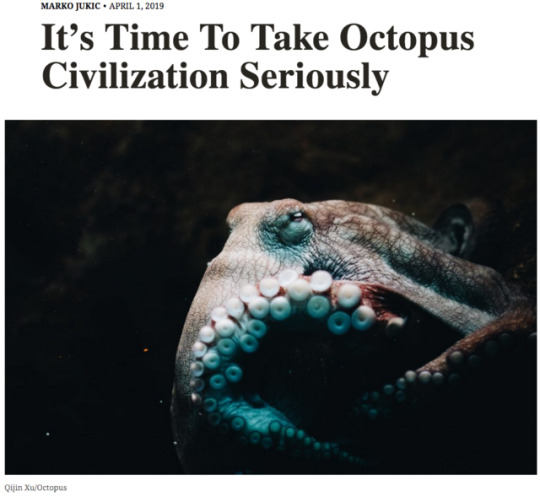
Intelligence is a hot topic of discussion these days. Human intelligence. Plant intelligence. Artificial intelligence. All kinds of intelligence. But while the natures of human and plant intelligence are subjects mired in heated debate, derision, and controversy, the subject of artificial intelligence inspires an altogether different kind of response: fear. In particular, fear for the continued existence of any human civilization whatsoever. From Elon Musk to Stephen Hawking, the geniuses of the Zeitgeist agree. AI will take our jobs and then, if we’re not careful, everything else too, down to every last molecule in the universe. A major Democratic presidential candidate, Andrew Yang, has turned managing the rise of AI into one of the core principles of his political platform. It is not a laughing matter.
But artificial general intelligence is not the type of intelligence that humanity should fear most. Far from the blinking server rooms of Silicon Valley or the posh London offices of DeepMind, another type of intelligence lurks silently out of human sight, biding its time in the Lovecraftian deep. Watching. Waiting. Organizing. Unlike artificial intelligence, this intelligence is not hypothetical, but very real. Forget about AGI. It’s time to worry about OGI—octopus general intelligence.
In late 2017, it was reported that an underwater site called “Octlantis” had been discovered by researchers off the coast of Australia. Normally considered to be exceptionally solitary, fifteen octopuses were observed living together around a rocky outcropping on the otherwise flat ocean floor. Fashioning homes—dens—for themselves out of shells, the octopuses were observed mating, fighting, and communicating with each other. Most importantly, this was not the first time that this had happened. Another similar site called “Octopolis” had been previously discovered in the vicinity in 2009.
One of the researchers, Stephanie Chancellor, described the octopuses in “Octlantis” as “true environmental engineers.” The octopuses were observed conducting both mate defense and “evictions” of octopuses from dens, defending their property rights from infringement by other octopuses. The other “Octopolis” site had been continuously inhabited for at least seven years. Given the short lifespans of octopuses, lasting only a few years on the high end, it is clear that “Octopolis” has been inhabited by several generations of octopuses. We are presented with the possibility of not only one multi-generational octopus settlement chosen for defense from predators and engineered for octopus living, but two. And those are just the ones we’ve discovered. The oceans cover over 70% of Earth’s surface.
None of the three experts I spoke with for this article would rule out the possibility of further octopus settlements.
The octopus is a well-known creature, but poorly understood. The primal fear inspired by the octopus frequently surfaces in horror movies, pirate legends, political cartoons depicting nefarious and tentacled political enemies, and, understandably, in Japanese erotic art. For all that, the octopus is, to most people, just another type of seafood you can order at the sushi bar. But the octopus is more than just sushi. It’s more than the sum of its eight arms. A lot more, in fact—it may be the most alien creature larger than a speck of dust to inhabit the known ecosystems of the planet Earth. Moreover, it’s not just strange. It’s positively talented.
Octopuses can fully regenerate limbs. They can change the color and texture of their skin at will, whether to camouflage themselves, make a threat, or for some other unknown purpose. They can even “see” with their skin, thanks to the presence of the light-sensitive protein rhodopsin, also found in human retinas. They can shoot gobs of thick black ink with a water jet, creating impenetrable smokescreens for deceit and escape. Octopuses can use their boneless, elastic bodies to shapeshift, taking on the forms of other animals or even rocks. Those same bodies allow even the larger species of octopuses to squeeze through holes as small as one inch in diameter. The octopus’ arms are covered in hundreds of powerful suckers that are known to leave visible “octo-hickeys” on humans. The larger ones can hold at least 35 lbs. each. The suckers can simultaneously taste and smell. All octopus species are venomous.
Despite all of these incredible abilities, the octopus’ most terrifying feature remains its intelligence. The octopus has the highest brain-to-body-mass ratio of any invertebrate, a ratio that is also higher than that of many vertebrates. Two thirds of its neurons, however, are located in its many autonomous arms, which can react to stimuli and even identify and grab food after being severed from the rest of the octopus, whether still dead or alive. In other words, the intelligence of an octopus is not centralized. It is decentralized, like a blockchain. Like blockchains, this makes them harder to kill. It has been reported that octopuses are capable of observational learning, short- and long-term memory, tool usage, and much more. One might wonder: if octopuses have already mastered blockchain technology, what else are they hiding?
We can see octopuses frequently putting this intelligence to good use, and not only in their burgeoning aquatic settlements. Some octopuses are known to use coconut shells for shelter, even dismantling and transporting the shell only to reassemble it later. In laboratory settings, octopuses are able to solve complex puzzles and open different types of latches in order to obtain food. They don’t stop there, though. Captive octopuses have been known to escape their tanks, slither across the floor, climb into another tank, feast on the helpless fish and crabs within, and then return to their original tank. Some do it only at night, knowingly keeping their human overseers in the dark. Octopuses do not seem to have qualms about deceiving humans. They are known to steal bait from lobster traps and climb aboard fishing boats to get closer to fishermen’s catches.
One octopus in New Zealand even managed to escape an aquarium and make it back to the sea. When night fell and nobody was watching, “Inky”—his human name, as we do not know how octopuses refer to themselves in private—climbed out of his tank, across the ground, and into a drainpipe leading directly to the ocean.
Given the advanced intelligence and manifold abilities of octopuses, it may not be a surprise, in hindsight, that they are developing settlements off the coast of Australia. By establishing a beachhead in the Pacific Ocean, a nascent octopus civilization would be well-placed to challenge the primary geopolitical powers of the 21st century, namely, the United States and China. Australia itself is sparsely inhabited and rich in natural resources vital for any advanced civilization. The country’s largely coastal population would be poorly prepared to deal with an invasion from the sea.
I spoke with Piero Amodio, a graduate student at the University of Cambridge who has been interviewed by The New York Times on his research into octopus intelligence. “[Octopuses] live in almost all marine habitats, from ocean depths to shallow waters, and from tropical to polar regions,” he said. “The fact that octopuses tend to have a solitary lifestyle is something extremely interesting because they differ from many other groups of large-brained animals.” Amodio linked me to a paper documenting food and den sharing among octopuses. What if they are, in fact, not so different? What if they become social on a scale matching or surpassing humans? Is humanity prepared to grapple with an organized challenge rising from all corners of the globe?
This new information does raise one important question: what are the state of human-octopus relations, and how might they develop in the future? Currently, octopuses are more than just aware of us. They are able to recognize individual human beings and develop preferences for them. If you are on good terms with an octopus, you may be grabbed and pulled into a tank, perhaps for a hospitable visit to the den. Alternately, you may be blasted and soaked with cold water. No octo-hickeys for you. Although many octopuses have shown obvious displeasure with captivity, they are fortunately not generally known to attack humans. There is, however, video footage of at least one dangerous altercation with a human diver. Graziano Fiorito, a senior researcher at the Stazione Zoologica Anton Dohrn in Naples, Italy, told me that aggression is “very rare” and done in self-defense. But with an animal as intelligent and disciplined as the octopus, could that same peaceful nature become warlike aggression if provoked?
Roko’s Basilisk is a well-known thought experiment postulating that a supremely powerful artificial intelligence might retroactively punish humans who did not work to bring it into existence. In this light, it is fortunate that octopuses have been legally protected by animal welfare laws during experimentation—the only invertebrates to receive this protection. We can only imagine what horrible, tentacled punishments for humanity may have been avoided in the event of an octopus intelligence singularity.
Animal welfare laws notwithstanding, human-octopus relations are clearly insufficiently advanced to guarantee stable and productive cooperation in the future. Octopus meat remains a fixture of many national cuisines. Octopus farming is a major industry, despite warnings and objections from the scientific community. Not one national government in the world has clarified its policies regarding octopus civilization. (Emails to the White House requesting the administration’s comment on this matter went unanswered.)
The first step to improving human-octopus relations would be a global shutdown of all consumption and internment, whether for research or commercial purposes, of octopuses. As this plan is patently unrealistic and completely absurd, more creative solutions will have to be developed in order to route around sclerotic global institutions unwilling or unable to meet the challenge of intelligent cephalopod life. One option may be to establish persistent contact with leaders in the octopus community to communicate our goodwill. While the linguistic barrier remains an unsolved problem, the incentives to solve it are enormous. Cultural and scientific exchange with octopuses could greatly enrich humanity’s understanding of undersea life, blockchain technology, and non-standard tactile numeracies.
Hostile approaches must also remain on the table in case peaceable cooperation proves to be impossible. Although the advents of aviation and long-range missiles have rendered coastal fortifications somewhat deprecated in modern military conflict, human regimes would do well to bolster their brown water borders in the event of a kinetic assault by octopodal forces. Extension of maritime frontiers into international waters would also provide a much-needed geopolitical buffer zone, provided it did not veer into encroachment upon cephalopod territory. With powerful suckers studding an arm span up to 4 meters long, distance is key to defense from the octopus. Sanctions could prove useful in denying octopuses any strategic reserves of coconut shells or other armor.
There is a more speculative moonshot option as well. Given the relatively short lifespans of octopuses, it would be possible to intern a number of them in a research station with the goal of selectively breeding them for intelligence, combat aptitude, and most importantly, loyalty to humans. With adequate funding, a team could make significant progress in just a few decades towards developing a new species of killer octopus bred to defend humanity against the threat of a rival octopus civilization. Just as OpenAI took the lead in confronting the problem of artificial intelligence by aiming to deliberately develop friendly AI, OctoAI may need to take the lead in confronting the problem of octopus intelligence by developing it ourselves in a humanity-friendly direction. We may have to fight ink with ink.
A moonshot project such as this has the added perk that it could be easily funded and carried out by a rogue government agency or single eccentric billionaire, such as SoftBank founder Masayoshi Son. The Farallon Islands off the coast of San Francisco, for example, would provide an ideal research site. They are a short boat ride away from the capital of unconventional moonshot projects in Silicon Valley, as well as being located in the natural territory of the Giant Pacific Octopus. The islands’ status as a nature preserve would provide a convenient cover story for the public. Intruders, spies, and conscientious objectors could be thrown into the octopus tank for disposal and their disappearances blamed on harsh Pacific weather. In fact, given the ideal conditions of the site, this may already be happening. Is it a coincidence that the Farallon Islands are closed to the public?
If all fallbacks fail, mutually assured destruction will be the only surefire way to prevent octopus civilization from annihilating humanity and conquering the cosmos. ”I tend to think that future-of-evolution questions are always limited by how long this planet continues to sustain life,” said Joseph Vitti, a doctoral student at Harvard University who has published on cephalopod cognition. “I tend to think that a natural or man-made disaster could easily wipe us out before enough evolutionary time passes for such major changes [in octopus social systems] to occur in the coleoid cephalopod lineage.” If we cannot save ourselves, we just may have to produce such a man-made disaster in order to save the rest of the universe.
The future may look bleak. Just as our social institutions enter a time of stagnation, crisis and despair, a heavily armed challenger surfaces from the untraversed depths. But humanity has faced terrible problems before and emerged not only victorious, but stronger too. To survive, our governing institutions will need to have robust but flexible coordination, quick and skilled decision-making, and the capacity for subterfuge, dissimulation, and intelligence. Just like the octopus. And that is what Palladium Magazine is all about.
This story is satire. It’s April 1st. All quotes, however, are real, as are more of the octopus facts than you would like to believe.
33 notes
·
View notes
Link
“Giardiniera. (Say it with me, "jar-din-air-ah.") It's the quintessential Chicago condiment, one that's as brazen and boisterous as the city itself.This fiery mix contains some combination of pickled chiles, celery, cauliflower, carrots and olives submerged in oil. Like an edible exclamation point, giardiniera adds instant heat, crunch and acid to many of our city's iconic foods, including Italian beefs, Italian subs and deep-dish pizza.
Chef Paul Virant, of Vie Restaurant in suburban Western Springs, who included a recipe for giardiniera in his 2012 book, "The Preservation Kitchen," says that he didn't know about the dish until he moved to Chicago. "Being from St. Louis, you just didn't see giardiniera," he says.
As important as it is here, giardiniera wasn't invented in Chicago. It originated in Italy, where it means mixed pickles. Giardiniera also is the name for a female gardener, which is helpful insomuch as it alludes to the vegetables in the mix...giardiniera is the Italian way of preserving vegetables from the garden.”

“Though impossible to know the exact date, giardiniera undoubtedly appeared in Chicago along with the wave of Italian immigration that came to the city in the late 19th century. That's around the time V. Formusa Co., maker of the best-selling giardiniera brand, Marconi, opened...the company was founded in 1898 by Vincent Formusa, an immigrant from Termini Imerese, Sicily. "At first, he was importing oil and Italian produce...Then he got into the Sicilian method of preserving vegetables in oil."

“Using vinegar versus oil makes a huge difference in the finished product. "When it's packed in vinegar, it's an antipasti thing," says Graziano, best served with sliced charcuterie, olives or cheese. Graziano thinks of the Chicago-style giardiniera as more of a condiment.”
Since no condiment stands by itself, giardiniera needed a partner in crime before it could catapult to fame here. It found a home as the topping for Italian beef, the classic Chicago sandwich of thinly sliced roast beef that's often served with its roasting juices (or jus). "It's the perfect accompaniment for the Italian beef...That brightness and acidity really cuts through everything."

“While the Italian beef helped spread the gospel of giardiniera, people eventually started putting it on other foods.One thing everyone I talked to agreed on was that giardiniera is surging in popularity. The companies I talked to didn't have exact data on sales throughout the years but say the numbers have increased dramatically in the last decade.
"In the past 10 years, it's gone from a really niche Chicago thing to a national one," says Jeff Johnson, who estimates that V. Formusa sells around a million pounds of giardiniera a year. "First we saw a growth in the southern Chicago area, and now we are really growing across the country."

The Best Pizza Topping That You’ve Probably Never Heard About
“Giardiniera is a blend of chopped vegetables (celery, peppers, carrots, cauliflower, and sometimes olives, although they are a controversial element) pickled in vinegar. You can order giardiniera on pretty much everything in the Chicagoland area, and from anywhere, even national chains like Subway.”

“Zagat calls it “Chicago’s condiment,” but it’s also a full-blown obsession for many Chicagoans. “It’s good on pasta, it’s good on pizza, it’s really good on breakfast sandwiches,” Tibensky said. “And giardiniera with eggs? So good!” Just as Lebowski’s rug tied the room together, Chicago’s giardiniera is the linchpin of its daily meals—and the unsung hero of its famous pizzas. “This is a product that should be in the pantry of every house in America,” Randy Formella, who runs giardiniera company E. Formella & Sons, told me.”
(via The Best Pizza Topping That You’ve Probably Never Heard About | The Ringer)

Why Koreans Eat Pickles With Their Pizza
“For many Koreans, pizza is best served with pickles. The trend seems especially true among those much closer to Western cuisine — Korean Americans, for example — yet prefer a hint of something “familiar.”Pizza originated in Italy, and while there’s no rule telling what comes with it, many are puzzled why Koreans find pickles, of all possible choices, the perfect fit. Conventional side dishes include salad, garlic bread, cheese fries, mozzarella sticks and Buffalo wings, none of which obviously seems to match with pickles.”

“I did notice though that when Americans (or Canadians) talk about Pizza in Korea, they always wonder why it comes with a container of pickles (never mind the chunks of potato and whole sausage links on them). Some even act like it’s disgusting and that the combo makes absolutely no sense.”
youtube
“Koreans have a hard time with cheese and butter and other rich Western foods. It goes down better for us when there’s something to cut through the richness. My parents and grandmother used to come home and eat kimchi after a pasta or pizza dinner out. So the pizza companies give out the pickles for this purpose.”
“Koreans really DO eat the pickles with their pizza.”

“Now, I don’t know if you like pickles in your hamburgers, but as you probably know, there are many people who love eating pickles with, well, anything. Kimchi, as pickled vegetables, has a similar effect but is much more common in Korean culture.”
(via Why Koreans Eat Pickles With Their Pizza | NextShark)

GIARDINIERA
“You could call this the Italian equivalent of kimchi or sauerkraut, a seasoned pickled condiment that is often served with rich or fried foods to aid digestion.”
Recipe by: GIADA DE LAURENTIIS

#giardiniera#italianpickles#chicagogiardiniera#koreanpizza&pickles#pizza&giardiniera#iloveitalianfood
1 note
·
View note
Text
awaiting the verdict of the jaundice debt vs [redacted] trial is making me feel insane, so i feel like airing some of my thoughts about the double standards i’ve seen from his supporters in the ‘sjw’ circles particularly (those that generally see themselves as superior and immune to manipulation/ misinfo, those with high ‘social justice’ standards), even outside of the abuse allegations. just the standards and judgements of ‘character’, as it were.
i’ll start with the more recent-- 1)
[Debt], when speaking about Wright during his testimony, repeatedly misgendered him,
this is y’alls king?
2) someone will have to explain to me (it’s an expression. don’t, bcus you can’t) why kate moshpit speaking in his defense as an ex (and frankly, every other ex of his in the press) is completely credible to the point that it discredits the claims of [redacted], but [redacted]’s ex defending her is not credible and does not discredit the claims of debt.
3) apparently, [redacted] donating ‘only’ $1.3 million of a $3.5 million pledge to the ACLU renders her the antichrist. jaundice debt pledging to buy wounded knee and return it to sioux nation, and never having done so or even come near doing so, is apparently not worth note (under oath or not, if one goes by the principle of ‘your word is your bond’, why is it only the former that matters? & i have to say at the rate of the pearl-clutching about the former, one would think she pledged it and has not donated a single penny since, which is not the case)
4) jaundice defending roman polanski. i don’t really have much else to say here.
except:
believes there may be shady dealings behind the scenes concerning Polanski's arrest for a 30-year-old statutory rape charge.
sound familiar? i’m ultimately very suspect of those that subscribe to conspiracy theories right off the bat. speaks to what’s happening now, as well.
5) “Give me your take on why young, rich movie star-type guys pay for sex.
Let’s say there’s a young guy who’s successful, famous, rich, da-dah-dah, can have anything he wants anywhere in the world. We presume. At the same time, this fellow could meet a girl in a bar and say, “God, you’re great, let’s go make out,” and they just go slobber. In his brain, he’s thinking, maybe he would like to see her again. Maybe this girl that he met has a slightly ambitious side to her, a devious kind of thing where she starts twisting things around. The next thing you know, this girl says, “This motherfucker raped me,” and all he knows is that, “We felt each other’s tongues, all right.” Let’s say the tabloids get hold of it and say, “Well, he fucking did it,” and that spins around for a few days or weeks and, bing, the guy’s guilty in the eyes of the world before he even has a chance to speak.”
6) ok, back to double standards. both these people are white, and have privilege when it comes to that.
from [redacted], we have a tweet that was patronizing, insensitive, and meted out stereotypes, but she later tried to clarify.
for debt, we have :
Sources say he paid his first wife, Lori Anne Allison, $1.25 million to keep quiet after he allegedly left a long ranting message in which he repeatedly used the N-word.
use of racial slur confirmed by subpoenaed text messages
He moves to the couches in the living room and flips on the television. [Debt] has an affinity bordering on obsession with the bons vivants who had their late prime in the 1970s, whether it is Marlon Brando, Hunter S. Thompson or Don Rickles. “Rickles was the bravest comedian ever,” says De[bt]. “He’d say anything.” As proof, he finds a video of Rickles on a Dean Martin celebrity roast, turning to boxer Sugar Ray Robinson: “I want to thank Sugar Ray Robinson, who said to Rocky Graziano, ‘Hey, baby, you’re hurting me.’ Sugar Ray is a great champion. Sugar, we would ask you to talk, but you know the blacks, your lips lock.”
“Jesus,” says Waldman.
De[bt] insists it’s ballsy, not offensive. I mumble, “I don’t know about that.” De[bt] isn’t paying attention.
0 notes
Text
United States Steel Corporation (X) Q4 2022 Earnings Call Transcript
$X Q4 2022 Earnings Call Transcript #earnings #markets #investing
United States Steel Corporation (NYSE: X) Q4 2022 earnings call dated Feb. 03, 2023
Corporate Participants:
Kevin Lewis — Vice-President, Finance
Dave Burritt — President and Chief Executive Officer
Jessica Graziano — Senior Vice-President and Chief Financial Officer
Rich Fruehauf — Senior Vice President and Chief Strategy and Sustainability Officer
Analysts:
Alex Hacking — Citi — Analyst
Tristan…

View On WordPress
0 notes